Cultures blend jewelry traditions through historical trade routes like the Silk Road, migration patterns, and royal marriages that act as cultural conduits. You’ll find that global exchanges allow artisans to incorporate foreign materials and techniques while maintaining cultural identity. Colonial influences, while often disruptive, have led to innovative hybrid styles. Modern collaborations between craftspeople preserve heritage while meeting contemporary demands. The fascinating journey of cross-cultural jewelry tells stories spanning centuries of human connection.
Historical Trade Routes: The Original Catalyst for Cultural Jewelry Fusion
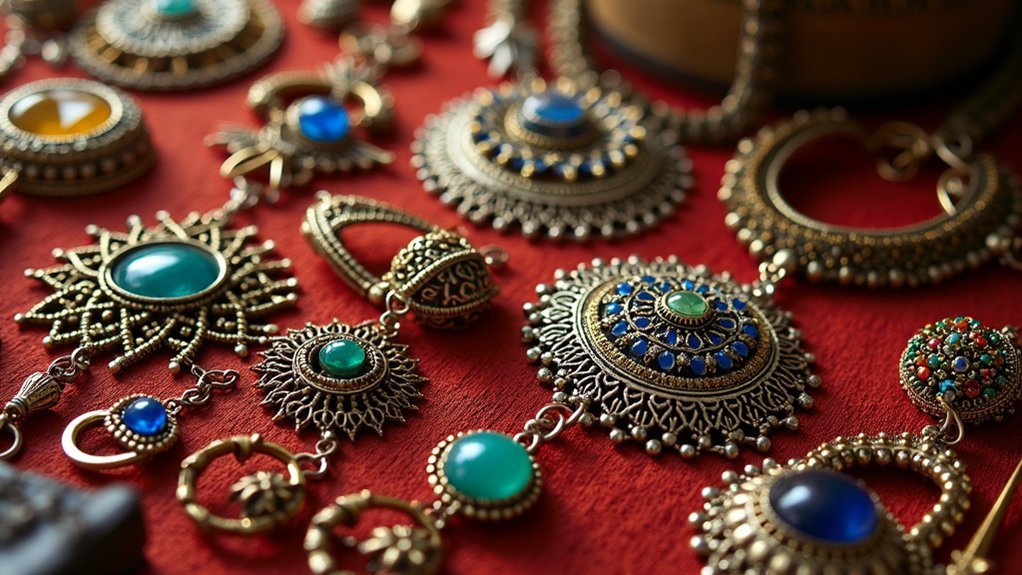
While many aspects of human heritage have evolved in isolation, jewelry creation stands as a remarkable exception due to the influence of ancient trade networks.
When you examine historical trade routes like the Silk Road, you’ll find they served as highways for more than goods—they transported cultural traditions and jewelry designs across continents.
These networks enabled artisans to access foreign materials and techniques, sparking the fusion of various jewelry traditions.
Artisans flourished as trade networks delivered exotic materials and techniques, catalyzing unprecedented jewelry innovation across cultures.
Goldsmithing methods from the Middle East transformed European craftsmanship, while exotic gemstones enhanced the cultural significance of local adornments.
As merchants traversed these routes, global influences merged with regional aesthetics, creating unique hybrid styles that reflected multiple civilizations.
The aesthetic diversity that resulted from these exchanges continues to inspire contemporary designs, showcasing how trade routes permanently altered humanity’s decorative arts.
Migration Patterns and Their Influence on Shared Jewelry Designs
Throughout history, as people moved across continents and borders, they carried more than just their physical possessions—they transported entire cultural traditions embedded in their jewelry.
These migration patterns have created powerful cultural exchanges that continue to shape jewelry traditions worldwide.
When you examine the hybrid styles in contemporary jewelry, you’ll notice how they reflect the multicultural identities of communities that have settled in new regions.
While historical trade routes like the Silk Road initiated this blending, modern globalization has dramatically accelerated it.
- Communities that relocate often incorporate elements from their host culture’s jewelry traditions into their own designs
- Intermarriage between different ethnic groups creates unique fusion pieces that honor both heritages
- Contemporary designers now intentionally draw from diverse artistic influences to create globally-inspired collections
Royal Marriages and Cross-Cultural Jewelry Exchange
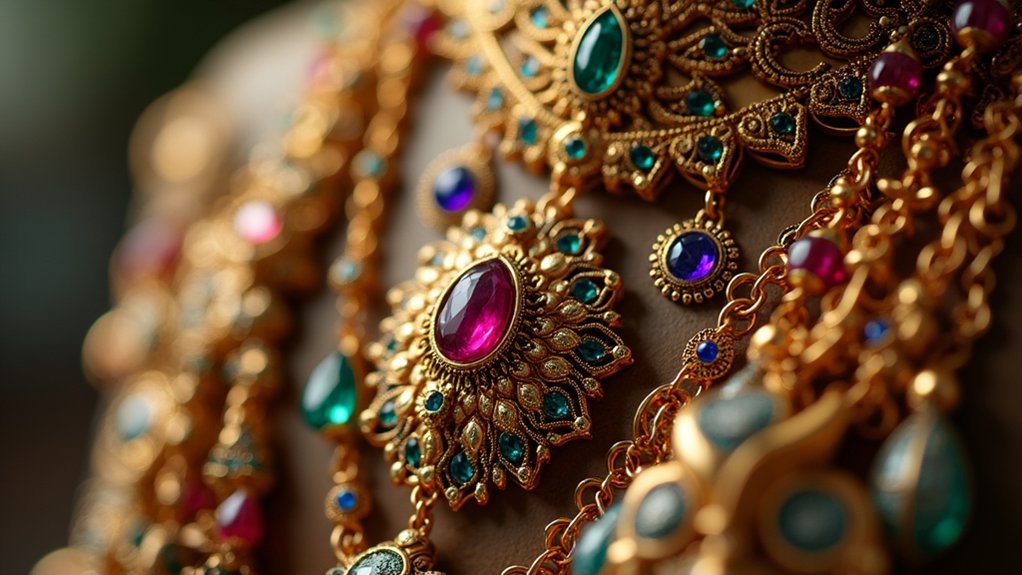
When royal families forge alliances through marriage, they don’t just unite bloodlines—they create powerful conduits for jewelry traditions to flow across borders.
You’ll notice this cultural fusion in Queen Victoria’s marriage to Prince Albert, which blended British and German intricate designs, influencing European jewelry for generations.
The Byzantine Empire exemplified how royal marriages integrated Western and Eastern influences, creating elaborate pieces with gemstones and goldwork that reflected both cultures’ symbolic meanings.
More recently, Prince Harry and Meghan Markle’s union showcased this shared heritage through her engagement ring, which combined diamonds from Botswana with one from Princess Diana’s collection.
Royal jewelry tells stories of heritage, as evident in Meghan’s ring blending African diamonds with Diana’s legacy stone.
These cross-cultural exchanges foster cultural appreciation beyond royalty, as seen in Western designers adopting Japanese Kintsugi techniques, celebrating the beauty found when different jewelry traditions meet.
The Silk Road’s Legacy in Blended Jewelry Traditions
The Silk Road stands as history’s most ambitious cultural crossroads, extending far beyond royal courts to transform jewelry traditions across continents. As you explore ancient pieces, you’ll discover how craftsmen blended Eastern and Western aesthetics, creating hybrid styles that reflect diverse cultural expressions.
The exchange wasn’t limited to gemstones and metals—it transferred spiritual significance and symbolic motifs across civilizations.
- Persian filigree techniques merging with Chinese symbolism, resulting in intricate pieces that honored both traditions’ craftsmanship
- Turquoise from Persian mines appearing in Central Asian designs, carrying different spiritual significance as it traveled westward
- Mediterranean metalworking methods adapting to incorporate Indian gemstone settings, creating jewelry that couldn’t have existed without this cultural blending
Colonial Impact on Indigenous Jewelry Practices
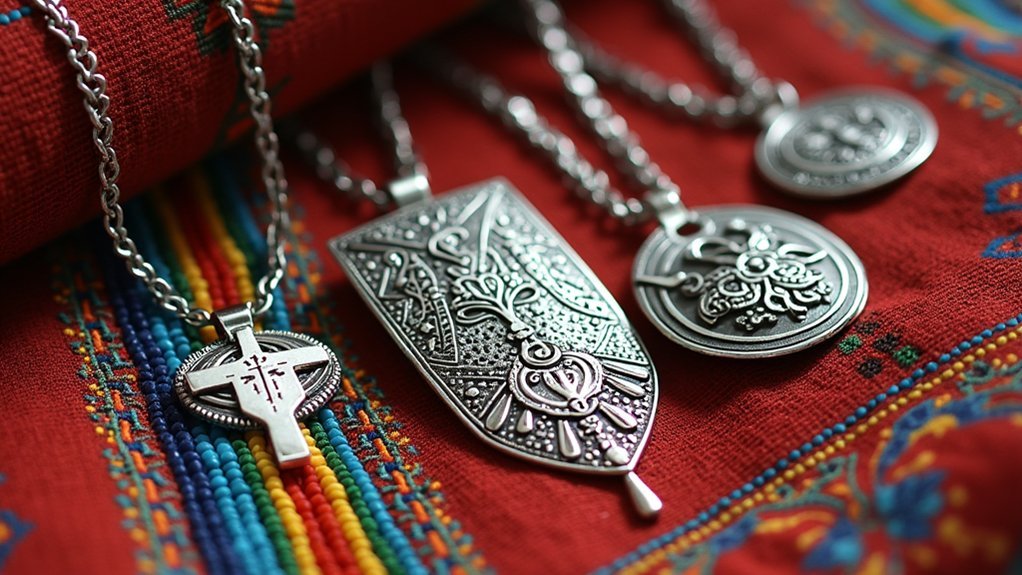
As colonial powers extended their reach across continents, indigenous jewelry traditions faced unprecedented disruption that forever altered their evolution.
You’ll find that colonialism forced artisans to adapt their craftsmanship when traditional methods were restricted and cultural symbols devalued.
Foreign materials and mass-produced pieces replaced native resources, while colonial traders appropriated indigenous designs without understanding their authenticity or significance.
The jewelry became divorced from its cultural identity as communities incorporated cheaper alternatives and foreign techniques.
Despite these challenges, indigenous jewelry hasn’t disappeared.
Instead, you’re witnessing a remarkable revitalization where artisans blend traditional practices with contemporary influences.
This resurgence represents more than artistic expression—it’s a reclamation of heritage.
Communities are now preserving ancestral techniques while embracing innovation, demonstrating jewelry’s enduring role in cultural resilience.
Modern Globalization and the Democratization of Cultural Motifs
Unlike the colonial era’s forced adaptations, today’s global interconnectivity has transformed jewelry traditions through voluntary exchange and mutual appreciation.
You’ll notice how modern globalization allows artisans to seamlessly blend traditional designs with contemporary aesthetics, creating pieces that honor multiple cultural heritages simultaneously.
- Social media and e-commerce platforms connect jewelry designers with global audiences, enabling cultural motifs to travel across borders more organically than ever before.
- Collaborative projects between artists from different backgrounds produce innovative fusions that preserve cultural heritage while creating fresh artistic traditions.
- The democratization of design encourages respectful borrowing across cultural boundaries, maintaining traditional craftsmanship while making it relevant to today’s consumers.
This cultural fusion celebrates diversity while ensuring ancient techniques remain vibrant in contemporary markets.
Artisan Collaborations Across Borders: Creating New Traditions
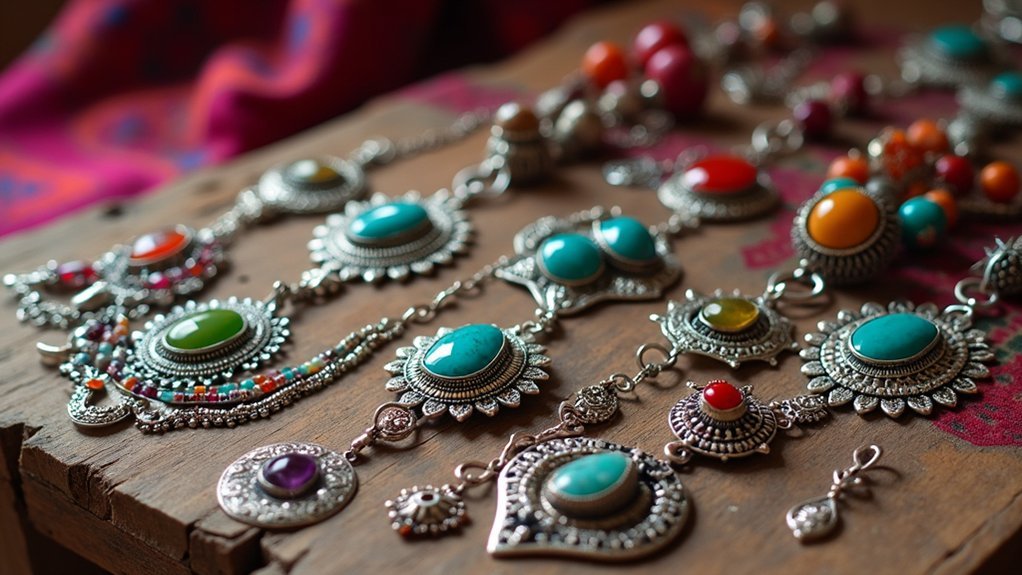
Crossing oceans and traversing continents, artisan collaborations have emerged as powerful catalysts for jewelry innovation in our interconnected world.
You’ll find diverse cultural techniques merging as craftspeople blend Indian goldsmithing with African beadwork, creating pieces that tell multiple cultural narratives simultaneously.
When you examine these innovative designs, you’re witnessing traditional craftsmanship evolving while maintaining cultural significance.
Artisans preserve traditional motifs while reinterpreting them in a modern context, allowing you to connect with global influences through wearable art.
These collaborations offer more than beautiful jewelry—they foster cross-cultural understanding between creators and wearers alike.
For the artisans themselves, these partnerships create economic opportunities by introducing their work to international markets, ensuring ancient traditions continue thriving in our global community.
Preserving Heritage Through Adaptive Jewelry Techniques
While traditions evolve over time, adaptive jewelry techniques have become essential guardians of cultural heritage.
You’ll find artisans incorporating traditional craftsmanship methods like filigree and granulation into authentic modern designs that appeal to contemporary aesthetics without sacrificing cultural identity.
Through collaborative efforts between master craftspeople and innovative designers, these techniques guarantee cultural sustainability for generations to come.
The synergy of masters and innovators safeguards cultural jewelry traditions while propelling them into future relevance.
- Regional materials such as sterling silver and indigenous gemstones ground modern pieces in their cultural origins while adding distinctive character to innovative designs.
- Historical techniques including cloisonné and beadwork are revived through adaptive approaches, preserving cultural heritage that might otherwise fade away.
- The fusion of traditional craftsmanship with contemporary vision creates jewelry that tells ancestral stories while meeting today’s market demands.
Frequently Asked Questions
What Culture Wears a Lot of Jewelry?
You’ll find abundant jewelry in Indian, African (especially Maasai), Middle Eastern, Latin American indigenous, and Southeast Asian cultures. They’re wearing these adornments to display wealth, status, cultural identity, and traditional significance.
Why Is Jewelry Important in Society?
You’ll find jewelry is important in society because it expresses your identity, marks significant life events, communicates cultural heritage, displays social status, and tells personal stories through its designs and materials.
What Does Jewelry Symbolize?
Jewelry symbolizes your identity, status, and cultural heritage. It’s a personal expression that can represent commitments, spiritual beliefs, protection, or mark life changes. You’ll find meanings in materials, gemstones, and designs you choose.
What Is the Cultural Significance of Jewelry?
Jewelry reflects your cultural identity through meaningful symbols and traditions. You’ll often see it marking significant life events, preserving heritage, displaying status, and connecting you to ancestral practices across generations.
In Summary
When you explore the rich tapestry of blended jewelry traditions, you’re witnessing humanity’s enduring connection across time and space. Through trade routes, migrations, royal alliances, and modern collaboration, cultures don’t just share techniques—they create new expressions of beauty. As you wear these fusion pieces, you’re participating in an ancient dialogue that continues to evolve while honoring the diverse heritage from which it springs.

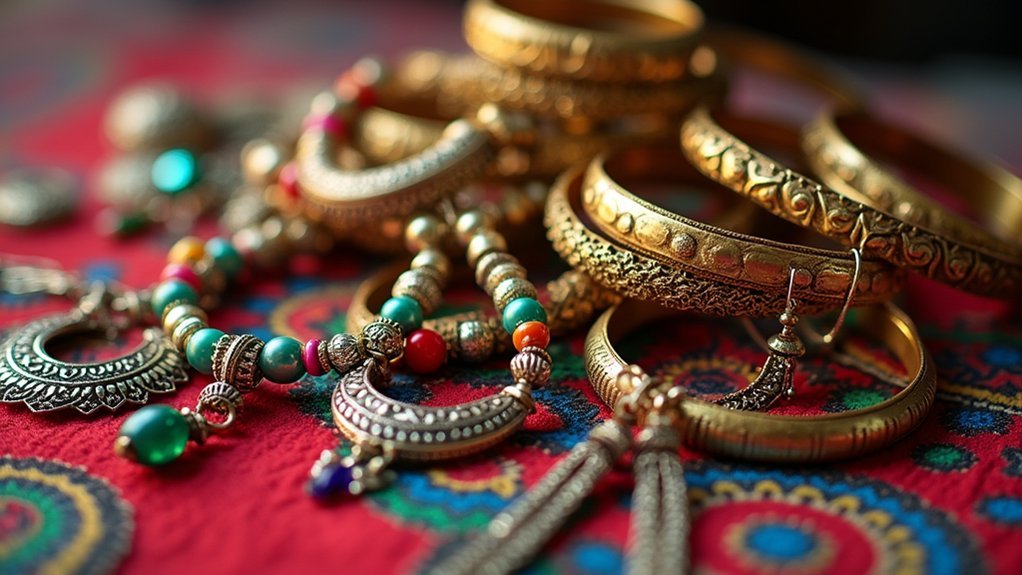



Leave a Reply